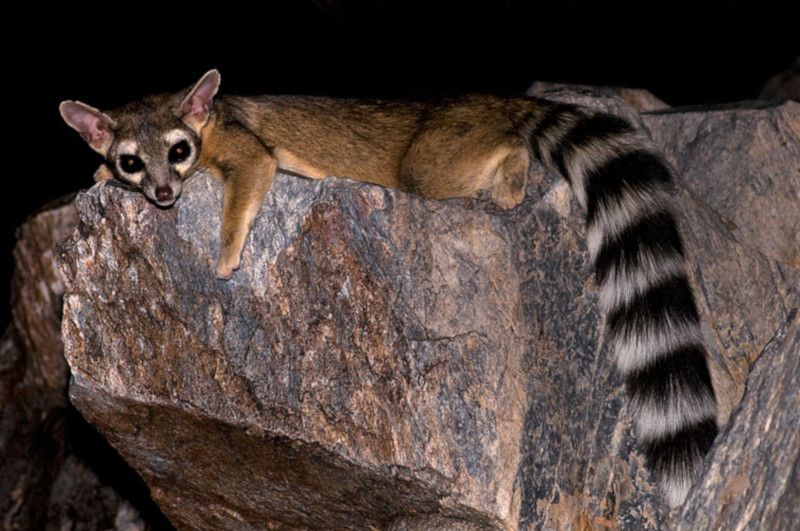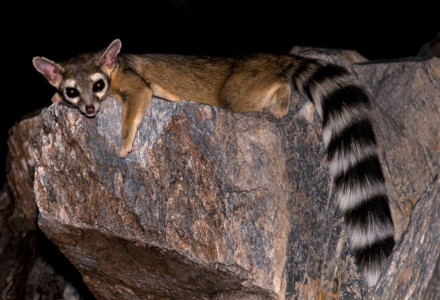
Ring-Tailed Cat Facts
- The descriptive term of Ring-Tailed Cat excellently serves as one of several common names for a remarkable variety of mammal. Despite that particular term for it, however, the visually impressive creature has absolutely no relationship to any feline species.
- A few of its other commonly used names, meanwhile, include such terms as the miner’s cat, the ringtail cat, and the bassarisk. On the other hand, however, its scientific name remains that of the relatively hard to pronounce term of the Bassariscus astutus.
- The animal received this tongue-twisting name at the time of its first scientific recognition, in the year 1830. This scientifically important recognition occurred at the hands of the respected German zoologist, Martin Hinrich Carl Lichtenstein.
- Most fortunately, the marvelous animal also appears to be maintaining a population base that is both sufficient and stable. This seems to hold true throughout the entirety of its native range. The IUCN, therefore, presently lists it as Least Concern.
- The remarkable mammal nonetheless must be considered to be facing at least some risks, though. Given mans encroachment on its territory, habit loss poses a very real threat. Its greatest danger, though, no doubt comes in the form of climate change.
Related Articles
Ring-Tailed Cat Physical Description
Although the remarkable Ring-Tailed Cat remains an impressive species, it doesn’t earn that status due to sheer size. In point of fact, it’s a comparatively small variety of mammal. Somewhat surprisingly, it actually remains smaller than the average house cat.
The animal further distinguishes itself from may other mammals in another way. This particular species displays no noticeable degree of the physiological trait of sexual dimorphism. While perhaps not technically rare, this does remain somewhat uncommon.
Mature adults of both genders attain an average body length of roughly 12 – 17 in (30 – 42 cm). These same individuals also develop a tail that also averages about the same length. Its weight also remains slight, measuring an average mass between 1.5 – 3.3 lb (0.7 – 1.5 kg).
The coloring of both genders of the Ring-Tailed Cat typically present as a buff to dark brown color, in random patches, on the body. The tail, however, displays the marvelous pattern of 14 – 16 black rings, which serves as the source of one of the common names.
- Kingdom: Animalia
- Phylum: Chordata
- Class: Mammalia
- Order: Carnivora
- Family: Procyonidae
- Genus: Bassariscus
- Species: B. astutus
Ring-Tailed Cat Distribution, Habitat, and Ecology
The magnificent Ring-Tailed Cat inhabits a moderately large section of the globe. This range covers a significant portion of the continent of North America. More specifically, though, this region includes part of the United States and the country of Mexico.
Within this relatively extensive range, though, the animal evolved as highly adaptable. As a result, it inhabits a wide range of habitat types. These include such regions as deserts, semi-arid areas, pine and oak woodlands, conifer forests, and chapparal.
The animal also appears within a broad range of altitudes. Individuals occur at heights of as much as 9,514 ft (2,900 m). Most though, live from sea level to around 4,593 ft (1,400 m) above sea level. It further prefers areas of canyons, rocky outcroppings, and talus.
The awesome Ring-Tailed Cat evolved as omnivorous in nature, like related species. Although it does display a decided preference for meat, it also consumes a moderate amount of vegetation. Its prey mainly consists of small animals, such as birds and frogs.
Its own predators, meanwhile, consist of several different species. These include such animals as coyotes, raccoons, bobcats, owls, and hawks. It does, however, have one means of defense. It evolved a gland that releases a highly pungent musk when threatened.
Species Sharing Its Range
Check out our other articles on 4 Amazing North American Deserts, Black-and-white hawk-eagle, Salar de Uyuni, Mary River Turtle, Violet Carpenter Bee, Antarctic Beech

